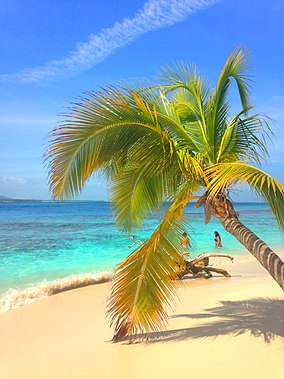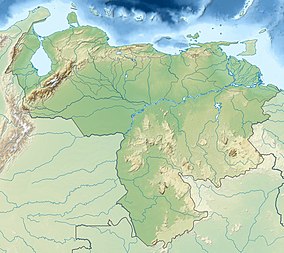Morrocoy National Park
| Morrocoy National Park | |
|---|---|
|
IUCN category II (national park)
|
|

Cay Sombrero
|
|
|
Location in Venezuela
|
|
| Nearest city | Tucacas and Chichiriviche |
| Coordinates | 10°51′22″N 68°18′22″W / 10.856°N 68.306°WCoordinates: 10°51′22″N 68°18′22″W / 10.856°N 68.306°W |
| Area | 320.9 km2 |
| Established | 26 May 1974 |
| Governing body | INPARQUES |
Morrocoy National Park is located in the easternmost coast of Falcón state and northwestern of Golfo Triste, in the west central Venezuelan coast, near the towns of Boca de Aroa, Tucacas, Sanare, Chichiriviche, Flamenco and , and consists of 32,090 acres. It was declared a national park on May 26, 1974 by Executive Order No. 113, Official Gazette No. 30408 on May 27, 1974.
The park extends across both terrestrial and aquatic areas of Golfo Triste. It contains an area of mangroves and numerous islets or cays among which are Borracho, Muerto, Sombrero, Sal, Las Animas and Peraza, among others. There are spectaculars white sand beaches on these cays; Mero, Paiclas, los Juanes, Playuela, Tucupido, Azul, Boca Seca and many more. The park's internal bays and mangroves, cays and islands sit in the relief of Chichiriviche hills, with elevations of 250 m.
The Declaration as a National Park or Protected Area means the following:
From Caracas, take the Central Regional Highway to past the dealer Guacara (approximately 140 km). Variant is taken by highway via Yagua to Puerto Cabello. Arriving at El Palito take the highway to Puerto Cabello in Morón address. In the Morón dealer takes the highway Morón-Tucacas and after traveling 40 km it reach the entrance to the Morrocoy National Park.
The park is inhabited by numerous species of birds, about 266, as report by Cuare Wildlife Refuge. Because Morrocoy National Park and Wildlife Refuge Cuare are located in the same geographic area, it is inferred that the park should be have a similar number. Some notable species are: the osprey; vulnerable species such as flamingo, palette heron, pelican; species of birds whose preferred habitat is the mangrove nesting and resting such as, Neotropic, Chusmita or white Garcita, the helmeted cockaded, the amazona real parrot, the red scarlet ibis, pechiblanca heron (tricolored heron); and species with restricted distribution such as the frigatebird or earwig. Tues mangroves of Morrocoy Bay are excellent bird sanctuaries, especially on the island of Pájaros located in the central area of the park, which is covered with mangrove cay.
...
Wikipedia

